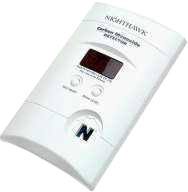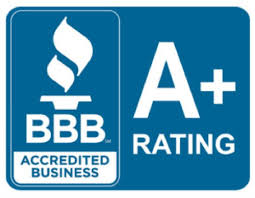 This model has a direct plug with digital readout, peak level memory, test button & battery back-up + hideaway cord. Nighthawk Carbon Monoxide Alarms are designed to monitor carbon monoxide levels continuously. This alarm will not only alarm if a high level of carbon monoxide is detected, but also if continuous lower levels are sensed. The alarm will sound within 90 minutes at 100 ppm (parts per million), within 35 minutes at 200 ppm, and within 15 minutes at 400 ppm. The digital display on the face of the unit shows the current level of carbon monoxide detected. In the event the detector alarms, it retains in high memory the highest reading since the unit was last reset. This means that even if carbon monoxide levels have dropped since the alarm sounded, the service technician or fire department can verify the level of carbon monoxide originally detected. AC powered alarm features:
This model has a direct plug with digital readout, peak level memory, test button & battery back-up + hideaway cord. Nighthawk Carbon Monoxide Alarms are designed to monitor carbon monoxide levels continuously. This alarm will not only alarm if a high level of carbon monoxide is detected, but also if continuous lower levels are sensed. The alarm will sound within 90 minutes at 100 ppm (parts per million), within 35 minutes at 200 ppm, and within 15 minutes at 400 ppm. The digital display on the face of the unit shows the current level of carbon monoxide detected. In the event the detector alarms, it retains in high memory the highest reading since the unit was last reset. This means that even if carbon monoxide levels have dropped since the alarm sounded, the service technician or fire department can verify the level of carbon monoxide originally detected. AC powered alarm features:
- 9 volt battery backup in case of a power outage
- May be plugged directly into an AC outlet or used on a tabletop with an 8-foot AC cord (included).
- Digital readout of CO level from 0 to 999 parts per million
- Peak level memory and display
- Test/reset button
- Loud 85 decibel alarm
- UL listed
How to recognize the effects of carbon monoxide.Thirty-five PPM of COHb in an 8 hour period is the maximum exposure allowed by OSHA in the workplace.
Carbon monoxide poisoning is often confused with “flu like symptoms” such as headache, nausea, dizziness.
Make sure all family members are aware of symptoms:
(airborne concentration levels ) Duration of Exposure Symptoms
- 100 ppm within 2 to 3 hours Slight headache
- 400 ppm within 1 to 2 hours Frontal headache
- within 2.5 to 3.5 hours Widespread headache
- 800 ppm within 45 minutes Dizziness, nausea, convulsions
- 1600 ppm within 20 minutes Headache, dizziness and nausea within 1-2 hours!!!! Death!
- 3200 ppm within 5-10 minutes Headache, dizziness and nausea within 1 hour!!!! Death!
- 6400 ppm within 1-2 minutes Headache, dizziness and nausea within 25-30 minutes!!!! Death!
- 12,800 PPM within 1-3 minutes!!!! Death!
COHb Symptoms and Medical Consequences
- 10% No symptoms. Heavy smokers can have as much as 9% COHb.
- 15% Mild headache
- 25% Nausea and serious headache. Fairly quick recovery after treatment with oxygen and/or fresh air
- 30% Symptoms intensify. Potential for long term effects especially in the case of infants, children, the elderly, victims of heart disease and pregnant women.
- 45% Unconsciousness
- 50%+ Death
How many carbon monoxide detectors should you have and where should you place them?
The Consumer Product Safety Commission recommends a detector on each floor of a residence. At a minimum, a single detector should be placed on each sleeping floor with an additional detector in the area of any major gas burning appliances such as a furnace or water heater. Installation in these areas ensures rapid detection of any potentially malfunctioning appliances and the ability to hear the alarm from all sleeping areas.





